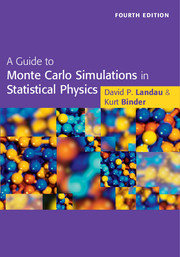Book contents
- Frontmatter
- Contents
- Preface
- 1 Introduction
- 2 Some necessary background
- 3 Simple sampling Monte Carlo methods
- 4 Importance sampling Monte Carlo methods
- 5 More on importance sampling Monte Carlo methods for lattice systems
- 6 Off-lattice models
- 7 Reweighting methods
- 8 Quantum Monte Carlo methods
- 9 Monte Carlo renormalization group methods
- 10 Non-equilibrium and irreversible processes
- 11 Lattice gauge models: a brief introduction
- 12 A brief review of other methods of computer simulation
- 13 Monte Carlo simulations at the periphery of physics and beyond
- 14 Monte Carlo studies of biological molecules
- 15 Outlook
- Appendix: Listing of programs mentioned in the text
- Index
- References
14 - Monte Carlo studies of biological molecules
Published online by Cambridge University Press: 05 November 2014
- Frontmatter
- Contents
- Preface
- 1 Introduction
- 2 Some necessary background
- 3 Simple sampling Monte Carlo methods
- 4 Importance sampling Monte Carlo methods
- 5 More on importance sampling Monte Carlo methods for lattice systems
- 6 Off-lattice models
- 7 Reweighting methods
- 8 Quantum Monte Carlo methods
- 9 Monte Carlo renormalization group methods
- 10 Non-equilibrium and irreversible processes
- 11 Lattice gauge models: a brief introduction
- 12 A brief review of other methods of computer simulation
- 13 Monte Carlo simulations at the periphery of physics and beyond
- 14 Monte Carlo studies of biological molecules
- 15 Outlook
- Appendix: Listing of programs mentioned in the text
- Index
- References
Summary
Introduction
The combination of improved experimental capability, great advances in computer performance, and the development of new algorithms from computer science have led to quite sophisticated methods for the study of certain biomolecules, in particular of folded protein structures. One such technique, called ‘threading’, picks out small pieces of the primary structure of a protein whose structure is unknown and examines extensive databases of known protein structures to find similar pieces of primary structure. One then guesses that this piece will have the same folded structure as that in the known structure. Since pieces do not all fit together perfectly, an effective force field is used to ‘optimize’ the resultant structure, and Monte Carlo methods have already begun to play a role in this approach. (There are substantial similarities to ‘homology modeling’ approaches to the same, or similar, problems.) Of course, the certainty that the structure is correct comes primarily from comparison with experimental structure determination of crystallized proteins. One limitation is thus that not all proteins can be crystallized, and, even if they can, there is no assurance that the structure will be the same in vivo. Threading algorithms have, in some cases, been extraordinarily successful, but since they do not make use of the interactions between atoms it would be useful to complement this approach by atomistic simulations. (For an introductory overview of protein structure prediction, see Wooley and Ye (2007).) Biological molecules are extremely large and complex; moreover, they are usually surrounded by a large number of water molecules. Thus, realistic simulations that include water explicitly and take into account polarization effects are inordinately difficult. There have also been many attempts to handle this task by means of molecular dynamics simulations, but the necessity of performing very long runs of very large systems makes it extremely difficult (if not impossible) to reach equilibrium. We are thus in the quite early stages in the study of biological molecules via Monte Carlo methods, but, as we shall see, results are quite promising for the future. The field is developing rapidly, and in some ways we are passing through the same kind of maturation period as Monte Carlo enthusiasts in physics did 30–40 years ago in which simulations were, at first, not taken too seriously by experimentalists. This will surely change.
- Type
- Chapter
- Information
- A Guide to Monte Carlo Simulations in Statistical Physics , pp. 465 - 476Publisher: Cambridge University PressPrint publication year: 2014



